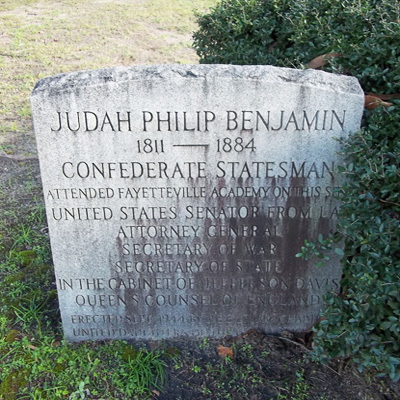
Judah P. Benjamin Marker, Fayetteville
The Judah P. Benjamin memorial is a simple granite tablestone with a flat arch top standing about 3-feet tall. It is unadorned aside from the inscription. Although the inscription says the marker was erected by the J.E.B. Stuart Chapter of the United Daughters of the Confederacy (U.D.C.) it was actually paid for and presented to the U.D.C. by the Fayetteville B’nai B’rith Lodge.
JUDAH PHILLIP BENJAMIN / 1811 – 1884 / CONFEDERATE STATESMAN / ATTENDED FAYETTEVILLE ACADEMY ON THIS SITE / UNITED STATES SENATOR FROM LA. / ATTORNEY GENERAL / SECRETARY OF WAR / SECRETARY OF STATE / IN THE CABINET OF JEFFERSON DAVIS / QUEEN’S COUNSEL OF ENGLAND / ERECTED SEPT. 1944 BY JEB STUART CHAPTER / UNITED DAUGHTERS OF THE CONFEDERACY
St. John’s Episcopal Church
September 1944
35.054800 , -78.877190
View in Geobrowse
MacKethan, Lulie Biggs. Chapter Histories, North Carolina Division, United Daughters of the Confederacy, 1897-1947 (The Division, 1947) Link
Solomon, Zachary. “What to Do About the Jewish Slaveholders?” Jewish Telegraphic Agency, www.jta.org, October 19, 2015, (accessed January 18, 2023) Link
Swint, H.L. “An Able Statesman of the Confederacy,” The Tennessean (Nashville, TN), January 16, 1944
“Historical News,” The North Carolina Historical Review 23.2 (1946), 283 Link
“Judah P. Benjamin Marker, Fayetteville, NC,” Waymarking.com, (accessed January 27, 2017) Link
Yes
Granite
B’nai B’rith in honor of the J.E.B. Stuart Chapter United Daughters of the Confederacy
The maker was presented to the United Daughters of the Confederacy by Mrs. Harry Stein on behalf of the B’nai B’rith. Miss Margaret Broadfoot, J.E.B. Stuart Chapter President presided for the ceremony and Mrs. E.R. MacKethan accepted on behalf of the U.D.C.
A biography of Judah P. Benjamin by Robert Douthat Meade published in late 1943 renewed interest nationally in the Confederate statesman who had “fallen into obscurity.” The fact that this marker was placed in late 1944 and sponsored by the B’nai B’rith is likely related to the interest the book sparked.
The Fayetteville B’nai B’rith Lodge also created a Judah P. Benjamin scholarship to the North Carolina College for Women (now UNC-Greensboro). The scholarship was to be made through the J.E.B. Stuart Chapter of the Daughters of the Confederacy.
Benjamin was raised in Charleston, South Carolina, the son of Sephardic Jews who had emigrated from England via the West Indies. After attending Yale, Benjamin moved to New Orleans, where he became a lawyer and wealthy slave owner. He was a United States Senator representing Louisiana when the Civil War broke out and offered his services to the Confederacy. Jefferson Davis appointed him Attorney General making him the first Jew to hold a cabinet level position in an American government. After the Civil War he fled to exile in England where he became a barrister and eventually a counsel to Queen Victoria. He is considered to be one of the least understood and most controversial figures in Jewish American history. He has been called “the brains of the Confederacy” by some historians and then blamed for the South’s defeat by others. He died on May 6, 1884 in Paris, France.
[Additional information from NCpedia editors at the State Library of North Carolina: This person enslaved and owned other people. Many Black and African people, their descendants, and some others were enslaved in the United States until the Thirteenth Amendment abolished slavery in 1865. It was common for wealthy landowners, entrepreneurs, politicians, institutions, and others to enslave people and use enslaved labor during this period. To read more about the enslavement and transportation of African people to North Carolina, visit https://aahc.nc.gov/programs/africa-carolina-0. To read more about slavery and its history in North Carolina, visit https://www.ncpedia.org/slavery. - Government and Heritage Library, 2023.]
The marker is on the property of St. John's Episcopal Church. It stands near the sidewalk in front of the historic Kyle House which is to the right of the church proper. The church address is 302 Green Street in Fayetteville, NC.
The memorial marker stands under a mature shady tree and surrounded by bushes.
 Know anything else about this monument that isn't mentioned here? If you have additional information on
this or any other monument in our collection fill out the form at the Contact Us link in the footer. Thank you.
Know anything else about this monument that isn't mentioned here? If you have additional information on
this or any other monument in our collection fill out the form at the Contact Us link in the footer. Thank you.

